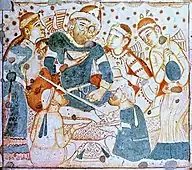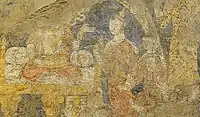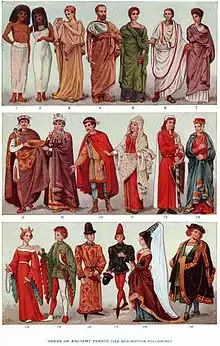Chamail (clothing)
The chamail is a type of poncho-like clothing from Central Asia.[2]

Statue of the Buddha wearing the Iranian three-pointed chamail, Ghorband valley, Fondukistan monastery, circa 700 CE.[1]

Buddha wearing a crown and cape. Painting in niche "I" at Bamiyan, 7th century CE.
As a result of Central-Asian influence, this type of clothing also appears in Indian works of art of the 1st millennium CE, as in Ajanta or Bagh.[2] The chamail was probably introduced in India by the Sakas or the Kushans.[2] The chamail also appears in Gandharan Buddhist sites such as Fondukistan and Bamiyan, and even as far as Xinjiang.[2] In Kashmir also, the chamail appears on the Buddha or Bodhisattavas during the 6-7th century CE.[2]
Examples
 Gandhara King devotee wearing the chamail, 3rd-4th century CE
Gandhara King devotee wearing the chamail, 3rd-4th century CE
 Wearer of a chamail (right) in the Penjikent murals.[2]
Wearer of a chamail (right) in the Penjikent murals.[2] Servant wearing chamail dress, Penjikent
Servant wearing chamail dress, Penjikent
References
- Compareti, Matteo (2009). "Iranian Elements in Kaśmīr and Tibet Sasanian and Sogdian Borrowings in Kashmiri and Tibetan Art". Transoxiana. 14.
- Compareti, Matteo (2014). "Some Examples of Central Asian Decorative Elements in Ajanta and Bagh Indian Paintings". The Silk Road. 12: 40–41.
- Brancaccio, Pia (2010). The Buddhist Caves at Aurangabad: Transformations in Art and Religion. BRILL. pp. 80–82, 305–307 with footnotes. ISBN 978-9004185258.
- DK Eyewitness Travel Guide India. Dorling Kindersley Limited. 2017. p. 126. ISBN 9780241326244.
Sources
- Spink, Walter M. (2007). Ajanta: History and Development, Volume 5: Cave by Cave. Leiden: Brill. ISBN 978-90-04-15644-9.
This article is issued from Wikipedia. The text is licensed under Creative Commons - Attribution - Sharealike. Additional terms may apply for the media files.
